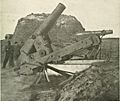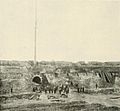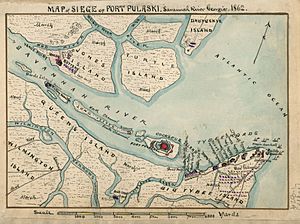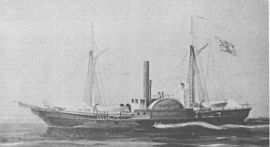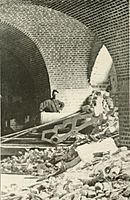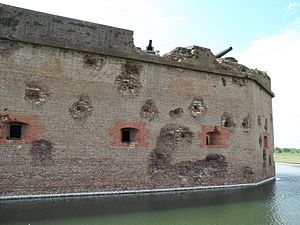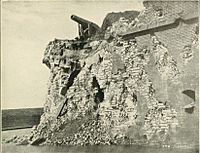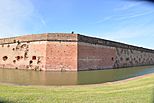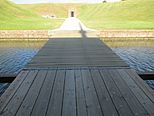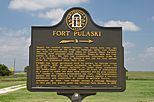Siege of Fort Pulaski facts for kids
Quick facts for kids Battle of Fort Pulaski |
|||||||
|---|---|---|---|---|---|---|---|
| Part of the American Civil War | |||||||
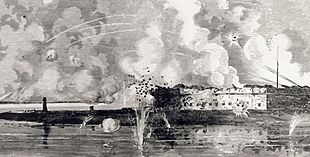 Fort Pulaski under fire April 10–11, 1862 from the Union's innovative Parrott rifle cannon and percussion shells. |
|||||||
|
|||||||
| Belligerents | |||||||
| Commanders and leaders | |||||||
| Samuel F. DuPont (Navy) David Hunter (Army) Quincy A. Gillmore (Siege) |
Robert E. Lee (Army) Josiah Tattnall III (Navy) Charles H. Olmstead (Fort) |
||||||
| Units involved | |||||||
|
Department of the South 10,000 officers and men 36 guns of all calibers 5 Parrotts, 5 James rifles |
Dept. of SC, Ga., Florida 385 officers and men 48 guns of all calibers 2 Blakely rifled cannons |
||||||
| Casualties and losses | |||||||
| 1 killed several wounded |
several mortally wounded 363 captured |
||||||
The Battle of Fort Pulaski happened on April 10–11, 1862, during the American Civil War. It was the final part of a long siege. Union forces on Tybee Island and their ships surrounded the Confederate-held Fort Pulaski. After a 30-hour attack with cannons, the Union captured the fort.
This battle was very important. It showed how powerful new rifled cannons were. These cannons could shoot farther and more accurately than older cannons. They made old-style forts, like Fort Pulaski, much less safe. The Union also used large-scale amphibious (land and sea) attacks for the first time under fire.
When the fort surrendered, the city of Savannah could no longer be used as a port by the Confederacy. The Union was able to make its blockade (stopping ships from entering or leaving) stronger along the Atlantic coast. Most of the Union's 10,000 troops could then be sent to other places. The Confederate defense had held off the Union for over three months. This protected Savannah and stopped the Union from attacking from the sea for the rest of the war.
Fort Pulaski is on Cockspur Island, Georgia. It is near the mouth of the Savannah River. The fort controlled the sea routes to the city of Savannah. Savannah was a very important city. It was a major port for exporting cotton. It was also a railroad hub and a big manufacturing center in Georgia.
Building Fort Pulaski
Fort Pulaski was part of the United States' "Third System" of coastal defenses. These were strong forts built to protect the coast. Construction on Fort Pulaski started in 1830 and finished in 1845. It was named after Casimir Pulaski, a Polish hero of the American Revolution.
A young engineer named Lieutenant Robert E. Lee helped build the fort. He lived in Savannah, Georgia, at that time. The new fort was meant to improve Savannah's defenses. It was located downriver from "Old" Fort Jackson, an older fort closer to the city.
In 1860, Southerners threatened to leave the United States if Abraham Lincoln became president. At first, the U.S. government did not put soldiers in forts in the South. This changed on April 12, 1861. South Carolina soldiers attacked Fort Sumter. This marked the start of the Civil War.
|
Confederates Take Control
-
A large gun used like a mortar
On January 3, 1861, Georgia left the Union. Volunteer soldiers quickly took over Fort Pulaski from the U.S. government. Confederate forces then began to repair and improve the fort's weapons. In November, General Robert E. Lee took command of the "Department of South Carolina, Georgia and Florida."
Colonel Charles H. Olmstead and his "First Volunteer Regiment of Georgia" guarded Fort Pulaski during the Union attack. Fort Pulaski was thought to be impossible to capture. It had 7.5-foot thick brick walls. Wide, swampy areas with alligators surrounded the fort. No attacking ship could get close enough to hit it well. Land cannons could not be placed closer than Tybee Island, which was one to two miles away.
Older, smoothbore cannons could not break through thick walls from far away. Beyond 1,000 yards, they had no chance. General Joseph Gilbert Totten, a U.S. engineer, famously said, "you might as well bombard the Rocky Mountains." People believed the only way to take the fort was to starve the soldiers inside.
Young soldiers at the fort worked hard to learn their duties. They practiced with the heavy cannons and learned infantry tactics. General Robert E. Lee, who had helped build the fort, knew the area well. He was in charge of defending the coast.
Preparing Defenses
When Union forces first landed on Tybee Island, work on Fort Pulaski was slow. But Robert E. Lee believed the river could not be forced. "Old" Fort Jackson was also made stronger. The channel to Savannah was blocked with obstacles. Lee thought the Union would not use the port, so he prepared for attacks elsewhere.

Lee brought Commodore Josiah Tattnall III to help. Tattnall's sailors had helped defend Richmond. They would do similar work near Savannah. Lee also ordered cannons to be placed to stop Union forces from getting behind Fort Pulaski.
In January, Tattnall's three gunboats attacked seven Union gunboats. Lee realized the Union could still reach the Savannah River. He decided the main goal was to defend the city itself. The city's floating dock was sunk to block the river even more.
In March, Lee was ordered to move troops from Florida to Tennessee. This was to help after some Confederate losses there. The Confederate government wanted troops moved from the coast to protect important farming areas. Lee then moved to Richmond. He gave detailed orders for defense. He told General Lawton to watch for the Union's likely approach to Savannah.
Cannons from island batteries were moved to the mainland around Savannah. Obstacles were placed in the river above the city. Lee wanted to stop the enemy from moving up the Savannah River. He said, "Every effort must be made" to slow them down. If the Union tried to build batteries on the marshes, they should be pushed back.
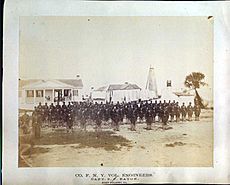
Savannah's existing Fort Jackson was strengthened with two more batteries. Defenders also built fire barges. Lee placed a battery at Causton's Bluff. This controlled waterways leading behind Fort Pulaski. Another battery was added on Elba Island, blocking all river access to Savannah.
The Union naval commander, Admiral Samuel F. Du Pont, checked Lee's defenses. When Union General Thomas W. Sherman wanted to attack Lee's river batteries, Du Pont disagreed. Sherman was then moved to another area, and General David Hunter took his place.
Union ships explored the coastal marshes. But when they met strong earthworks, like Fort McAllister, their attacks failed. The Union did not advance on Savannah until General William T. Sherman's march from the interior in 1864.
By April 1862, Fort Pulaski was cut off from Savannah. The fort's commander, Colonel Charles H. Olmstead, had 385 officers and men. They had 48 cannons, including ten large columbiads and a Blakely rifle. The fort had enough food for six months.
Olmstead had placed cannons to cover all possible attack routes. Confederate soldiers burned cotton crops so the Union could not use them. Navigation aids, like the Tybee Lighthouse, were also burned.
Union Advances
In August 1861, the U.S. Secretary of War approved a combined Army and Navy attack. General Thomas W. Sherman led the Army, and Flag Officer Samuel Du Pont led the Navy. Their goal was to take back Fort Pulaski. This would close Savannah's port to the Confederacy and strengthen the Union blockade. First, they needed a place to refuel their ships. The Battle of Port Royal helped them get a nearby staging area.
The Blockade
-
USS Unadilla, a gunboat in the blockade
As the Union took Port Royal, Confederate Commodore Josiah Tattnall III and his "mosquito fleet" fought back. They bothered the Union's South Atlantic Squadron. Tattnall trained his Confederate squadron. It became good at coastal, water, and supply operations.
When Du Pont's fifteen Union warships approached Port Royal, Tattnall's four Confederate gunships attacked. They were "outgunned and outclassed." They retreated. The next day, they helped evacuate Confederate soldiers from Port Royal. They also spiked (disabled) abandoned Confederate cannons.
First Contact
After setting up bases on Hilton Head Island, the Union prepared to attack Fort Pulaski. Next, they captured Tybee Island.
The Union moved on Fort Pulaski on November 24, 1861. Union scouts found that Confederates had left Tybee Island. Flag Officer Du Pont ordered an attack on the Tybee Island Lighthouse. After a two-hour bombardment from ships, Confederate guards set fire to the lighthouse and left.
Commander Christopher Raymond Perry Rodgers led Union sailors and Marines to take the Lighthouse. They raised the U.S. flag. Two days later, General Gillmore, the chief engineer, took control of the whole island without a fight. The Navy started bringing in supplies. By December 20, the Army had enough materials to stay there.
The last blockade runner (a ship that tries to get past a blockade) to reach Savannah was the British ship Fingal. It carried weapons and ammunition. It got into Wassaw Sound in November. Later, it tried to escape the blockade but failed. It was then turned into an ironclad ship. Fort Pulaski received two 24-pounder Blakely rifles and many British rifles from its cargo.
To close other channels, Union Flag Officer Du Pont sank stone-filled ships in the Savannah River. He also placed gunboats at two southern waterways. On November 26, Tattnall's flagship, CSS "Old" Savannah, attacked Union ships. They drove them out to sea. Two days later, the same three ships resupplied Fort Pulaski. They brought six months of food, despite Union ship attacks.
The Siege Begins
The Union's plan for the siege would make history. Quincy Adams Gillmore was General Thomas Sherman's chief engineer. He had studied new rifled cannons. He suggested a new plan to take Fort Pulaski using these cannons and mortars. General Thomas W. Sherman approved the plan. He did not fully believe the rifled cannons would work, but they proved him wrong. The new weapons made his large attack force of 10,000 men unnecessary. Neither Union General Sherman nor Confederate General Robert E. Lee thought the fort could be captured by cannons alone.
Setting Up Cannons
Two places for Union cannons were chosen upriver from the fort. This was to cut off Fort Pulaski from Savannah, just as Lee had expected. The first was at Point Venus. Confederate Commodore Josiah Tattnall III had sunk a ship to block the channel. The Union had to clear this obstacle first, which took three weeks. A supply base was set up on Dawfuskie Island.
Tattnall's gunboats still controlled the lower river. They patrolled constantly. Because of this, Union soldiers had to work at night to set up their cannons. The cannons had to be pulled by hand through alligator-filled swamps. Soldiers often sank waist-deep in the mud. The cannons had to be placed on special platforms so they would not sink. The soldiers rested during the day.
Lee believed the fort could only be taken by starving the soldiers inside. So, supplies were brought in as long as possible. The last Confederate supply ship to Fort Pulaski was the steamboat Ida. On February 13, it was on a regular trip. A new Union battery on the north bank opened fire. The Ida raced to Pulaski. The battery fired nine shots before the cannons recoiled off their platforms. Union troops then worked to fix the platforms. Two days later, the Ida returned to Savannah.
Once the Union battery at Venus Point was known, Confederate gunboats fought back. But they were driven away. Over the next week, the Union completely surrounded the fort. They built another battery across from Venus Point. They put a boom (a floating barrier) across Tybee Creek. They also cut the telegraph line to Savannah. Two infantry companies guarded the area. A gunboat patrolled the channel. By late February 1862, no supplies or soldiers could get into the fort. The Confederate soldiers inside could not get out. The only way to communicate was a weekly courier who swam through the swamp.
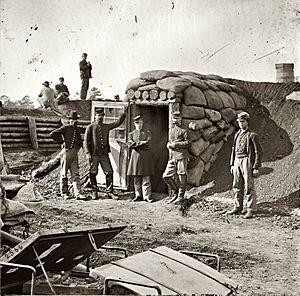
In February, Tattnall planned an attack on the Union batteries. But General Lee stopped him. Lee thought if Tattnall's plan failed, Savannah would be open to attack. So, no more attempts were made to help the fort. It still had about sixteen weeks of food. Meanwhile, Union positions kept getting better. During the battle, "Old Savannah" fired back at the Union cannons.
Heavy rifled cannons arrived in February. Gillmore decided to place the batteries at the northwestern tip of Tybee Island, closest to the fort. By March, Gillmore was unloading siege materials onto Tybee Island. Roads had to be built, cannon positions dug, and bomb-proof shelters made. As they got closer to the fort, Union troops came under fire from Confederate gunners. Colonel Olmstead himself was said to have aimed a shot that hit a Union soldier. The fort's cannons then forced all Union construction on Tybee Island to happen at night. Each morning, unfinished work was hidden from the fort's lookouts.
To get the cannons onto Tybee Island, they were taken off ships. They were put on rafts at high tide and floated to shore. At low tide, men dragged the cannons up the beach. Two hundred and fifty men were needed to move one large mortar. Later, escaped slaves helped with much of this work. Along the two-and-a-half-mile front, engineers had to build almost a mile of "corduroy road." This was made of bundles of brushwood to stop the cannons from sinking into the swamp. After a month of work, 36 mortars, heavy guns, and rifled cannons were in place.
One of the large mortars was given the job of signaling the start of the attack. It would fire shells that exploded after hitting the fort's walls.
The four batteries closest to the fort had specific targets. Battery McClellan was to break the corner between the south and southeast walls. Battery Sigel was to fire on the fort's cannons until they stopped. Then it would fire on the southeast walls. Battery Totten was to explode shells over the northeast and southeast walls. Battery Scott was to fire solid shots at the same area as Battery McClellan.
Firing was to stop at dark, but some harassment continued overnight. A signal officer helped guide the mortar batteries.
The Bombardment
Union Cannons at Fort Pulaski
| Battery | Cannons | Distance to Fort Pulaski |
|---|---|---|
| Battery Totten | 4 10-inch siege mortars | 1,650 yards |
| Battery McClellan | 2 84-pounder James rifles 2 64-pounder James rifles |
1,650 yards |
| Battery Sigel | 5 30-pounder Parrott rifles 1 48-pounder James rifle |
1,670 yards |
| Battery Scott | 3 10-inch and 1 8-inch columbiads | 1,740 yards |
| Battery Halleck | 2 13-inch mortars | 2,400 yards |
| Battery Sherman | 3 13-inch mortars | 2,650 yards |
| Battery Burnside | 1 13-inch mortar | 2,750 yards |
| Battery Lincoln | 3 8-inch columbiads | 3,045 yards |
| Battery Lyon | 3 10-inch columbiads | 3,100 yards |
| Battery Grant | 3 13-inch mortars | 3,200 yards |
| Battery Stanton | 3 13-inch mortars | 3,400 yards |
Rain stopped the action on April 9. But on April 10, everything was ready. Major-General David Hunter, the new Union commander, demanded that Fort Pulaski surrender. Colonel Olmstead replied, "I am here to defend the fort, not to surrender it."
The attack began at 8:00 a.m. Union cannons focused on the fort's southeast corner. This area was hit very hard. The Confederate gunners fired back with "great precision."
As the day went on, the fort's cannons were slowly silenced. They were either broken or could not be used. Some Union cannons also broke. The large 13-inch mortars were not very accurate. But the Parrott and James rifles, and working columbiad guns, were very effective. There was a quiet period from the fort. But then Confederate gunners started firing strongly again. The Parrotts had to stop hitting the walls and focus on silencing the fort's cannons again. By nightfall, the wall at the southeast corner was broken. The Union kept firing throughout the night. Olmstead's soldiers managed to get some cannons working again.
Overnight, 100 sailors from Du Pont's ship, USS Wabash, helped man four of the Parrott rifles. In the morning, the Union artillery started firing again. They focused on making the hole in the wall bigger. The Confederate gunners still fired well, causing some damage. But the Parrott rifles and Columbiads made a huge gap in the wall. Shots flew across the inside of the fort. They hit the northwest powder magazine, which held twenty tons of gunpowder. Colonel Olmstead saw that his situation was hopeless. He surrendered the fort at 2:30 p.m. that day.
General Gillmore reported that good rifled cannons could quickly break walls from 1600–2000 yards away. The 84-pounder James rifle was excellent for breaking walls. The 13-inch mortars did not do much. The new 30-pounder Parrott Rifle had a huge impact on the battle. Rifled cannons could fire much farther and more accurately. They also caused more damage than older, smoothbore cannons. Their use in this battle surprised everyone.
What Happened Next
Military Impact
- Union: The port of Savannah was closed to the Confederacy early in the war. This helped the Union blockade. The damage to the fort was fixed in six weeks. The Confederates never tried to take it back. Savannah itself stayed in Confederate hands until General William T. Sherman arrived in December 1864. After the war, it was clear that heavy rifled cannons made old masonry (brick and stone) forts useless. This changed how coastal defenses were built.
- Confederate: Commodore Josiah Tattnall III tried to break the Union blockade at Savannah. This led to the building of ironclad warships like CSS Atlanta (1862) and CSS Savannah (1863). To improve Savannah's defenses, a special station for torpedoes (underwater mines) was set up. The ironclad USS Montauk survived a torpedo explosion in 1863. The Confederates also built a floating battery called CSS Georgia (1863). Better railway connections in Savannah, Augusta, and Charleston helped move troops and supplies to Charleston from late 1862 to 1864.
The Confederates quickly learned from this battle. They used these lessons to improve the defenses of Charleston, South Carolina. Colonel Olmstead, after being released as a prisoner, helped with engineering and gunnery there. Union naval attacks on Charleston failed many times from 1862 to 1865. Union ships were often damaged by Confederate cannons and mines.
People and History
- Union: General David Hunter issued an order on May 9, 1862. It declared that all slaves in Florida, Georgia, and South Carolina were free. President Lincoln quickly canceled this order. He said that only he had the power to free slaves if it was needed to save the Union. Still, Fort Pulaski became a stop on the Underground Railroad. It started educating freed slaves. Many of the 517 African-American Georgians who served in the U.S. Navy from 1862–1865 came from here.
- Confederate: In late 1864, 520 Confederate officer prisoners were sent to Fort Pulaski. The fort's commander tried to give them full food rations. But he was ordered to put them on starvation rations. After a new commander took over, a medical check in January 1865 led to normal rations being given again. About 55 men died before they were moved to another fort in March 1865. These prisoners were known as the "Immortal Six Hundred".
Visiting Today
- Fort Pulaski is on a barrier island near Savannah, Georgia. It is open to the public as the Fort Pulaski National Monument and museum. It is a "Third System" fort. Robert E. Lee helped supervise its building. The fort's defense was set up under his command.
- Old Fort (James) Jackson is in Savannah. It is a "Second System" fort and museum. It covers history from the American Revolution, War of 1812, and Civil War.
- Fort McAllister is a Confederate earthen fort. It defeated Union ship attacks six times. It is now the Fort McAllister Historic Park, a Georgia State Park south of Savannah.
- Fort Pulaski National Monument in the 2000s
-
Wall that was breached and repaired with moat around the fort
-
Drawbridge over the moat







